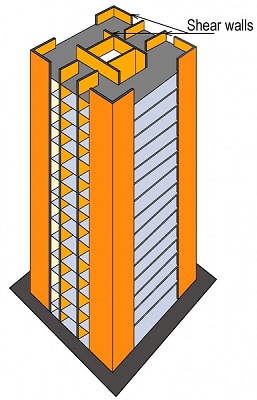Shear wall
A shear wall is a structural panel that can resist lateral forces acting on it.
Lateral forces are those that are parallel to the plane of the wall, and are typically wind and seismic loads. In simple terms, lateral forces could push over parallel structural panels of a building were it not for perpendicular shear walls keeping them upright.
When a structural member experiences failure by shear, two parts of it are pushed in different directions, for example, when a piece of paper is cut by scissors.
Shear walls are particularly important in large, or high-rise buildings, or buildings in areas of high wind and seismic activity.
Shear walls are typically constructed from materials such as concrete or masonry. Shear forces can also be resisted by steel braced frames which can be very effective at resolving lateral forces but may be more expensive.
Shear walls can be positioned at the perimeter of buildings or they may form a shear core – a structure of shear walls in the centre of a building, typically encasing a lift shaft or stairwell.
Lateral pressures tend to create a rotational force on the shear wall which, due to the shear wall acting as one member, produces a compression force at one corner and a tension force at another. When the lateral force is applied from the opposite direction, this ‘couple’ is reversed, meaning that both sides of the shear wall need to be capable of resolving both types of forces.
[edit] Related articles on Designing Buildings Wiki
Featured articles and news
Government consultations for the summer of 2025
A year of Labour, past and present consultations on the environment, the built environment, training and tax.
CMA competitiveness probe of major housing developers
100 million affordable housing contributions committed with further consultation published.
Homes England supports Greencore Homes
42 new build affordable sustainable homes in Oxfordshire.
Zero carbon social housing: unlocking brownfield potential
Seven ZEDpod strategies for brownfield housing success.
CIOB report; a blueprint for SDGs and the built environment
Pairing the Sustainable Development Goals with projects.
Types, tests, standards and fires relating to external cladding
Brief descriptions with an extensive list of fires for review.
Latest Build UK Building Safety Regime explainer published
Key elements in one short, now updated document.
UKGBC launch the UK Climate Resilience Roadmap
First guidance of its kind on direct climate impacts for the built environment and how it can adapt.
CLC Health, Safety and Wellbeing Strategy 2025
Launched by the Minister for Industry to look at fatalities on site, improving mental health and other issues.
One of the most impressive Victorian architects. Book review.
Common Assessment Standard now with building safety
New CAS update now includes mandatory building safety questions.
RTPI leader to become new CIOB Chief Executive Officer
Dr Victoria Hills MRTPI, FICE to take over after Caroline Gumble’s departure.
Social and affordable housing, a long term plan for delivery
The “Delivering a Decade of Renewal for Social and Affordable Housing” strategy sets out future path.
A change to adoptive architecture
Effects of global weather warming on architectural detailing, material choice and human interaction.
The proposed publicly owned and backed subsidiary of Homes England, to facilitate new homes.
How big is the problem and what can we do to mitigate the effects?
Overheating guidance and tools for building designers
A number of cool guides to help with the heat.
The UK's Modern Industrial Strategy: A 10 year plan
Previous consultation criticism, current key elements and general support with some persisting reservations.
Building Safety Regulator reforms
New roles, new staff and a new fast track service pave the way for a single construction regulator.

























